How can you clean a ceramic hob and how to do it correctly?
Caring for the surface of a glass-ceramic hob is not a burdensome task if you wipe it after each meal. But how to clean a glass-ceramic stove from burnt grease and dried stains, so as not to scratch or damage the surface?
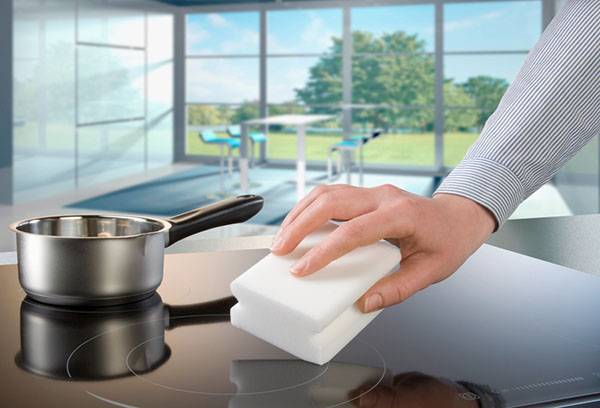
General rules for caring for glass ceramics
Electric stoves with a glass-ceramic surface are very convenient, but there are some nuances in caring for them. You can wash the hob only after it has cooled down, that is, after all the residual heat indicators have gone out. The exception is if syrup or jam is spilled on the stove. In this case, you need to immediately clean off the dirt with a scraper, but you can wipe it with sponges only after it has cooled.
Another feature is that not all devices that housewives use to clean stubborn dirt are suitable for cleaning. The following products cannot be used:
- metal brushes and sponges;
- coarse abrasives;
- strongly acidic cleaning chemicals.
Advice
Plastic sponges do not leave visible scratches, but they leave microdamages. After regular use, the appearance of the stove deteriorates, and dirt sticks more and more, so you need to use them as little as possible.
What can I use to clean the stove?
To clean fresh dirt, simply wipe the surface with any soft sponge and detergent, and then wash thoroughly with warm water and wipe with a cloth that absorbs moisture well.For these purposes, it is good to purchase a special microfiber cloth for glass. If stains still remain, you can spray a small amount of a solution of water and ammonia on the stove and wipe it dry.
Such everyday cleaning does not cause any particular difficulties, but how and how to clean a glass-ceramic stove from old dirt at home? You can use a special scraper. It can be sold complete with a stove. If not, you can purchase it at a home appliance store along with glass ceramic detergent.
The technology for cleaning carbon deposits with a scraper is slightly different from everyday cleaning. The stove should be cleaned when it is still warm, or heated a little so that the burnt fat softens slightly. Then, holding the scraper at an angle of 30-45º, use it to pry off the accumulated dirt. It is important not to rush, but to remove the burnt layer by layer, periodically wiping the surface with a damp cloth.
Another remedy for such cases is a melamine sponge. It erases dirt like an eraser. Before use, the sponge must be moistened with water. You can also use fine-grained abrasive pads, such as those suitable for Teflon cookware.
Complex, strongly ingrained stains are best washed using a combined method.
- Remove the top layer with a scraper.
- Apply detergent.
- Clean the hob with an abrasive sponge.
- Wash the surface with a wet cloth, rinsing it all the time, and wipe dry.
- If any dirt remains, wipe it off with a melamine sponge.
Which chemistry is the most effective?
The most acceptable option is to use cleaning products designed for glass ceramics.In addition to ingredients for removing contaminants, they contain substances that create a protective film on glass ceramics. It prevents the trapped dirt from becoming firmly embedded in the surface and makes the next cleaning easier.
Several companies produce such household chemicals, including manufacturers of glass-ceramic slabs. Examples include Domax, Top House, Kochfeld Pflegereiniger and Selena-extra. The latter product is produced by a Russian manufacturer, so the cost is significantly lower with the same quality as foreign analogues.
However, special products do not always cope with removing heavy carbon deposits. In this case, you can carry out “resuscitation” measures - wash the stove with grease removers for enamel. Usually these are gels, less often - liquid.
According to reviews, the following products are quite effective and gentle on the stove:
- "Adriel";
- Bagi grease remover “Shumanit”
- KENOLUX GRILL
It is worth remembering that grease removers are an exceptional measure, and their use can lead to a change in the color of the panel, the appearance of bluish or grayish spots.
Advice
Any household chemicals must be thoroughly washed off the surface to prevent prolonged exposure of glass ceramics to chemicals and their burning.
How to remove limescale?
This problem occurs if water often gets on the surface of the panel during cooking. As a result, it evaporates, and hardness salts settle on the glass ceramics. There are two ways to wash off plaque – using traditional or industrial chemicals. Stove manufacturers recommend using glass ceramic cleaners or household glass cleaners. The traditional method is also effective and does not damage the surface.In addition, it will help out if you don’t have household chemicals on hand, and the stove needs to be washed now. How to do it?
- Dilute water with 9% table vinegar in a ratio of 1/1. The required volume is 50-100 ml. You can add 10-20 ml of ammonia to the solution.
- Apply with a sponge or rag to a cooled surface and leave for 10-15 minutes.
- Wipe the hob first with a damp cloth, then with a dry cloth.
The most persistent stains
The hardest thing to remove from glass ceramics is burnt syrups, jam or milk with sugar. When sugar caramelizes, it adheres firmly to the surface. Attempts to remove such deposits at home often end in damage to the panel. You can often come across advice: “do not cook jam on glass ceramics”, “do not allow syrup to get on the stove”. But it’s rare that a housewife will refuse to prepare for the winter, and even the most attentive “cook” sometimes runs out of jam. That is why we will consider methods of dealing with the consequence - soot from syrup.
- If possible, any sweet liquid that gets on the surface should be immediately cleaned off with a scraper, and after the surface has cooled, wash it with a cleaning agent.
- Dark stains remaining after cleaning with a scraper can be removed by generously sprinkling them with salt and wiping after 15-30 minutes with a solution of water and vinegar.
- If it was not possible to clean the syrup immediately, you can sprinkle the stain with citric acid and pour in a little water. After this, you need to heat the stove a little and remove the burnt sugar with a scraper.
- Hardened sugar crust can be removed with a natural remedy - apple peel. To do this, you need to wipe the contaminated areas with it and leave it on top of the carbon deposits for 15 minutes, then wash the hob. If not everything is washed off, repeat the procedure.
How difficult is it to maintain glass ceramics?
For those who are just thinking about purchasing a glass-ceramic stove, a detailed description of the process of cleaning such a surface may seem lengthy and maintenance difficult. In fact, caring for such a hob is no more difficult than caring for a regular enamel-coated stove. If you choose the right tools and detergents, cleaning will take very little time and effort.
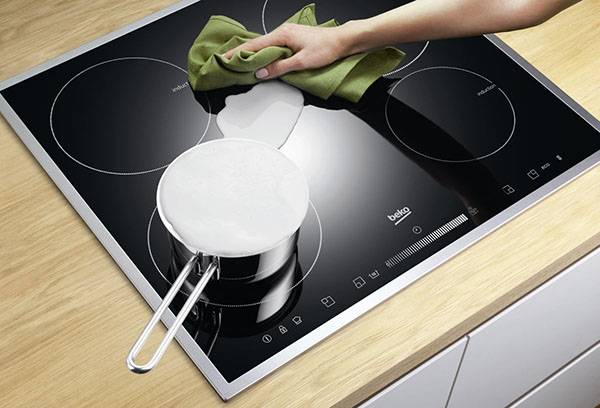
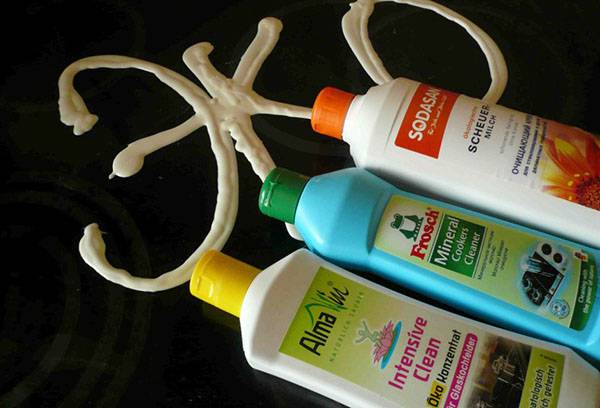
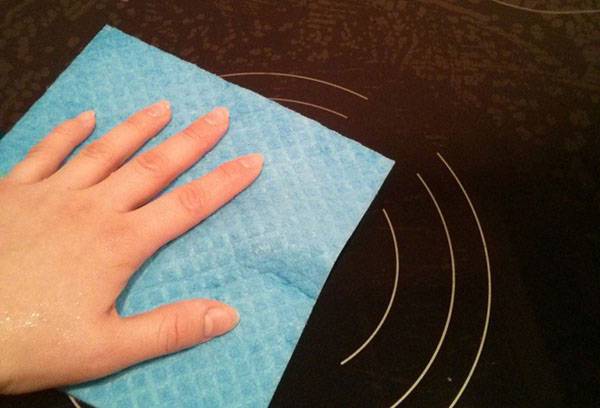
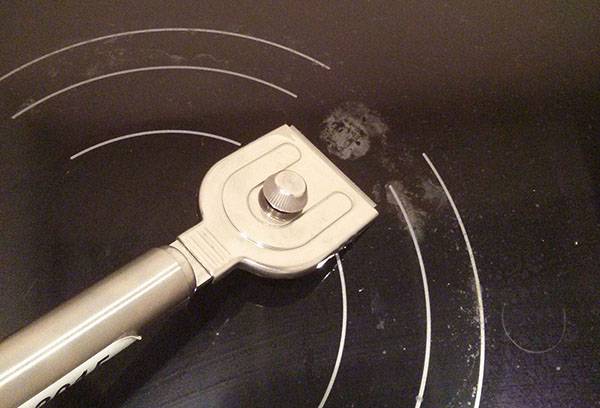
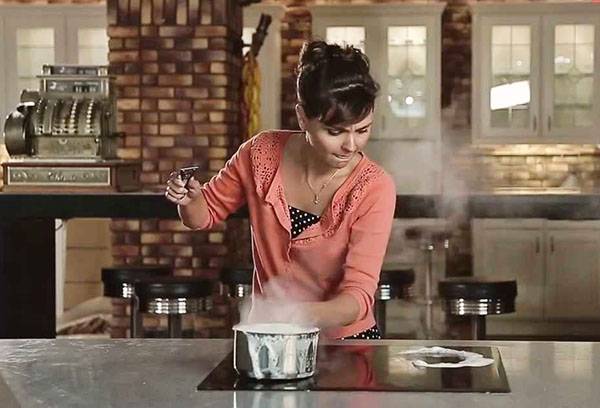
The Bagi “Shumanit” grease remover is a leader for me; I use it to wash pans, stoves and ovens)) it undoubtedly saves time significantly! You only need a little product and the fat is gone. And the other day I bought extra foam from schumanite for testing, how convenient it is, you can’t imagine, you spray it on your apron and it doesn’t run off, the consumption is minimal! And sometimes grease gets on my ceiling, the product really saves me, it doesn’t drip or fly anywhere, and most importantly, it washes off the grease! I was satisfied! Cleanliness for your home!
Well, I don’t know, I’d be afraid to clean an expensive coffee machine with lemon, you never know. I only clean mine with special products. When I bought my car in a store, I bought professional tablets in a set, they lasted a long time, and then I bought kumkumite, which is also good, there are special additives in it so as not to corrode the internal gaskets, but ordinary lemon juice is a thing of the past, in my opinion.